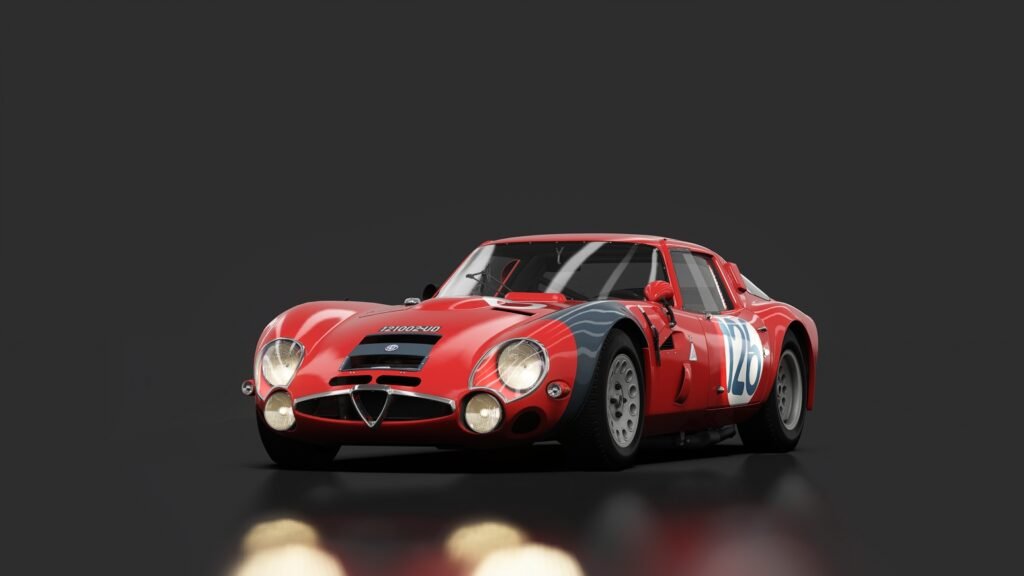
{{ galleryProps.activeIndex + 1 }}/1
Descrição
3d Model Conversion: GADU Boyz
EXTRA_BUTTONS:
- EXTRA_A: ignition
- EXTRA_B: starter
- EXTRA_C: front position lights
- EXTRA_D: rear endurance lights
- TAPE LIGHTS CAN BE ACTIVATED IN SETUP MENU
Alfa Romeo Giulia TZ2: history
A new version of TZ was introduced at the Turin Auto Show in 1964 in the Zagato stand. In order to reinforce the structure and further reduce the car's weight, Zagato replaced the light alloy body with an even more streamlined fibreglass body moulded tight to the chassis providing lower drag and reduced weight of 620 kg (1,370 lb). The new design was called the Alfa Romeo Giulia TZ2.
Aiding the TZ2 in its quest for performance was the treatment of the rear bodywork. Incorporating the research of Dr. Wunibald Kamm, the TZ2 used a style called coda tronca in Italian, meaning "short tail.", otherwise known as the Kamm tail. The principle is that unless an aircraft-like extended tail is incorporated, which is not practical for an automobile, there is little, if any, increase in drag and a marked decrease in lift or even some downforce by simply chopping off a portion of the tail.
The TZ2 was only...
3d Model Conversion: GADU Boyz
EXTRA_BUTTONS:
– EXTRA_A: ignition
– EXTRA_B: starter
– EXTRA_C: front position lights
– EXTRA_D: rear endurance lights
– TAPE LIGHTS CAN BE ACTIVATED IN SETUP MENU
Alfa Romeo Giulia TZ2: history
A new version of TZ was introduced at the Turin Auto Show in 1964 in the Zagato stand. In order to reinforce the structure and further reduce the car’s weight, Zagato replaced the light alloy body with an even more streamlined fibreglass body moulded tight to the chassis providing lower drag and reduced weight of 620 kg (1,370 lb). The new design was called the Alfa Romeo Giulia TZ2.
Aiding the TZ2 in its quest for performance was the treatment of the rear bodywork. Incorporating the research of Dr. Wunibald Kamm, the TZ2 used a style called coda tronca in Italian, meaning “short tail.”, otherwise known as the Kamm tail. The principle is that unless an aircraft-like extended tail is incorporated, which is not practical for an automobile, there is little, if any, increase in drag and a marked decrease in lift or even some downforce by simply chopping off a portion of the tail.
The TZ2 was only built as racing version. All TZ2 engines were prepared by Virgilio Conrero’s Autotecnica Conrero shop in Torino. They took Alfa’s DOHC Inline-4 four, gave it ultra-light magnesium casings and the cylinder head from the GTA. The1,570 cc DOHC straight-4 engine producing around 170 bhp (127 kW) at 7500 rpm. With this engine the car reached top speed of 245 km/h.
Chassis manufacture was sub-contracted to Ambrosini and Chief Designer Busso fitted new 13-inch diameter Campagnolo wheels to replace TZ1’s 15-inch units.
Inside, the steeply raked windscreen limited space so reclining seats were fitted and the steering column was lowered as well as the entire dashboard. Since the transmission tunnel sat so much higher in the TZ2, the length of the gearshift was substantially lowered.
Development of TZ cars was stopped in the end of 1965, to make room for the new Alfa Romeo GTA racing program. Only 12 TZ2s were built.
Alfa Romeo Giulia TZ2: the victories
Due to the small displacement engine, the Alfa Romeo Giulia TZ2 has to be content with bringing home class victories. The sexy Lombard coupé made its racing debut on 25 April 1965 with the category success at the 1000 km of Monza with our Roberto Bussinello and Andrea De Adamich (who also won the 1000 km of the Nürburgring with “Geki”).
1966 was the year in which the greatest satisfactions arrived (always class successes) for the Alfa Romeo Giulia TZ2: “Geki” and the Swiss Gaston Andrey first in the 12 Hours of Sebring, De Adamich and Teodoro Zeccoli in front to all their category rivals at the 1000 km of Monza, Enrico Pinto and Nino Todaro triumphant at the Targa Florio and the top step of the podium at the Nürburgring with the Belgian Lucien Bianchi and the German Herbert Schultze.
The last important victory for the Biscione sports car dates back to 1967 when the Belgian duo of Serge Trosch and Teddy Pilette gave the Lombard company its third category triumph at the Nürburgring.
Download Link
Simulador:
Assetto Corsa
Marca:
Alfa Romeo
Modelo:
TZ2
Potência:
170 cv
Torque:
197 nm
Peso:
620 kg
Peso/Potência:
3,65 kg/cv
Tração:
Traseira - RWD
Autor:
GADU Boyz Mod, Team WSC Legends
Versão:
1.2














